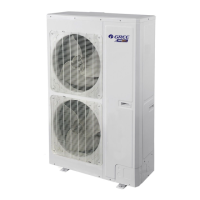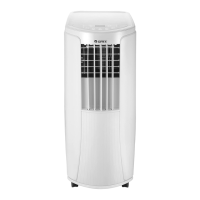DC Inverter Side Discharge VRF Ⅱ for North America
7
In cooling, the low-temperature and low-pressure refrigerant gas from each indoor
heat exchanger will be merged and inhaled by the compressor and then become
high-temperature and high-pressure gas, which will later be discharged into outdoor heat
exchangers. By exchanging heat with outdoor air, refrigerant will turn to liquid and flow to
each indoor unit via Y-type branch or manifold. Pressure and temperature of the
refrigerant will then be lowered by throttle elements before it flows into indoor heat
exchangers. After exchanging heat with indoor air, refrigerant wil become low-temperature
and low-pressure gas again and repeat the circulation so as to realize the cooling effect.
In heating, 4-way valve will be energized to make refrigerant circulate in a reverse
direction of cooling. Refrigerant will release heat in indoor heat exchangers (electric
heating elements will also work under certain circumstance and release heat) and absorb
heat in outdoor heat exchangers circularly so as to realize the heating effect.

